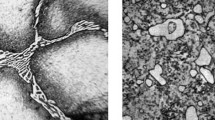It is shown that the Persian Kurdistan bulat steel blades (end of the XVIII century) correspond with respect to chemical composition to contemporary high-carbon steel (1.48 and 1.67% C), with a high content of phosphorus impurity (0.192 and 0.236% P). However, contemporary industry carbon tool steels are not used with this carbon and phosphorus content. It is revealed that the main distinguishing feature of ancient bulat steels from modern tool steels is layered heterogeneity with respect to composition, structure, and hardness distribution. Layered carbide heterogeneity develops in the form of patterns after polishing and etching in 3% alcoholic nitric acid solution. It is found that the carbide layers located in a troostite matrix consist of oblong shaped cementite with a 1/3 ratio of axes. The microhardness of carbide layers is determined in the range of values from 820 to 1020 HV. In troostite layers the range of microhardness values is from 390 to 560 HV. The layered distribution of microhardness in the edge of a bulat blade is a micro-saw with teeth from 50 to 100 microns. Tests for cutting edge resistance on cutting felt in a unit with a reciprocating mechanism are carried out. It is revealed that with low cutting forces (up to 40 N) bulat steel withstands a greater number of cuts than carbon tool steel with a uniform structure. With an increase cutting edge force from 6 to 12 kg bulat steel type Ds15P demonstrated 30% fewer cuts than by carbon tool steel type Y15А. It has been established that within the layered structure of bulat steel fatigue crack propagation from the instant of its occurrence to complete destruction occurs in a greater number of cycles than in the homogen eous structure of carbon tool steel. Old blades of bulat steel type Ds15P according to fatigue life indices show twice as long life compared to modern carbon tool steel type Y15А. Loss of cutting capacity is compensated by an increase in blade “viability” with repeated fatigue loads. Thermal tests are conducted for the impact strength of genuine bulat steel type Ds17P. It is shown that in the temperature range from 0 to +40°C impact strength increases by a factor of four. It is established that chemical and structural layering of bulat steel minimizes the negative impact of phosphorus impurities, and impact energy at failure increases by 35%.










Similar content being viewed by others
References
A. A. Sukhanov, “Structure formation of Indo-Persian phosphorus bulat,” Tend. Razvit. Nauki Obraz, No. 35(3), 24–34 (2018); doi.org/10.18411/lj-28-02-2018-46
D. A. Sukhanov, “Influence of phosphorus impurity on the structure and nature of the destruction of the genuine Damascus steel,” Int. J. of Engineering Technologies and Management Research (IJETMR), No. 5 (4), 26–37 (2018); doi.org/10.5281/ zenodo.1244689
Abu Raikhan Biruni, Collection of Information about Understanding Valuables (Mineralogy) [in Russian] Izv. Akad. Nuak. SSSR, Leningrad (1063).
I. S. Gaev, “Bulat and contemporary iron-carbon alloys,” MiTOM, No. 9, 17–24 (1965)
B. Zschokke, “Du Damasse et des Lamés de Damast,” Rev. de Metallurgie, No. 21, 635–669 (1924).
C. Panseri, “Damascus steel in legend and in reality,” Gladius, No. 4, 5–66 (1965).
F. N. Tavadze, B. G. Amaglobeli, and G. V. Inanishvili, “Mechanical properties of bulat steel,” Soobshch. A.N Gruz. SSSR, No. 3 (113), 589–592 (1984).
O. D. Sherby and J. Wadsworth, “Ultrahigh carbon steels, Damascus steels and superplasticity,” 9th Int. Metallurgical and Materials Congress (1997).
J. Wadsworth and O. D. Sherby, “On the Bulat–Damascus steels revisited,” Progress in Materials Science, No. 25, 35–68 (1980).
O. D. Sherby and J. Wadsworth, “Damascus steel,” Scientific American, No. 252 (2), 112–120 (1985); doi.org/10.1038/ scientificamerican0285–112.
I. N. Golikov, Dendrite Liquation in Steel [in Russian], Metallurgiya, Moscow (1958).
J. D. Verhoeven, A. H. Pendray, and E. D. Gibson, “Wootz–Damascus steel blades,” Materials Characterization, No. 37, 9–22 (1996); doi.org/10.1016/s1044-5803 (96)00019-8.
J. D. Verhoeven, “Pattern formation in wootz Damascus steel swords and blades,” Indian Journal of History of Science, No. 42 (2), 559–574 (2007).
D. A. Sukhanov and L. B. Arkhangel’skii, “Bulat microstructure,” Metallurg, No. 9, 112–115 (2015); doi.org/10.1007/ s11015-016-0178-x.
D. A. Sukhanov, L. B. Arkhangel’skii, and N. V. Plotnikova, “Nature of angular carbide in bulat steel,” Metallurg, No. 1, 1122–117 (2017); doi.org/10.1007/s11015-017-0451-7
M. R. Barnett, A. Sullivan, and R. Balasubramaniam, “Electron backscattering diffraction analysis of an ancient Wootz steel blade from Central India,” Materials Characterization, No. 60, 252–260 (2009); doi.org/10.1016/j.matchar.2008.10.004.
D. A. Sukhanov, L. B. Arkhangel’skii, and N. V. Plotnikova, “Mechanism of eutectic carbide formation type Fe2C in bulat steel structure,” Metallurg., No. 3, 57–64 (2018); doi. org/10.1007/s11015-018-0654-6
D. A. Sukhanov, L. B. Arkhangel’skii, and N. V. Plotnikova, “Damascus steel ledeburite class,” Materials Science and Engineering, No. 1 (175), 1–7 (2017); doi.org/10.1088/1757899X/175/1/012017
D. A. Sukhanov and L. B. Arkhangel’skii, “Eutectic carbides in Damascus steel ledeburite class (Wootz),” Int. J. of Mater. Sci. and Applications (IRJMSA), No. 6, 1–7 (2017); doi.org/escipub.com/ ijmsa-2017-06-1001
D. A. Sukhanov and N. V. Plotnikova, “Formation of faceted excess carbides in Damascus steels ledeburite class,” J. of Mater. Sci. and Eng. B, 8, No. 1–2, 36–44 (2018); doi.org/10.17265/21616221/2018.1-2.006
I. N. Taganov, “Workpiece legend of Bulat,” Kalashnikov, Oruzhie, Boepripasy, Snaryazhenie, No. 11, 92–97 (2009).
D. A., Sukhanov and N. V. Plotnikova, “Influence of the distribution of excess carbides on the properties of genuine Damascus steel,” Mater. Sci. and Applications, No. 10, 118–136 (2019); doi.org /10.4236/msa.2019.102010
D. A. Sukhanov, “Western phosphorus bulat,” Put’ Nauki, No. 1 (47), 29–38 (2018).
A. P. Vinogradov, “Soft bulat and origin of a bulat pattern,” Izv. Dnepro. Onsy., 15, 115–213 (1928).
V. I. Basov, “Bulat: lines of life,” Metallurg., No. 7, 16–23 (1991).
Yu. G. Gurevich, “Classification of bulat with respect to macro- and microstructure, MiTOM., No. 2, 3–7 (2007).
Author information
Authors and Affiliations
Corresponding authors
Additional information
Translated from Metallurg, Vol. 63, No. 11, pp. 50–60, November, 2019.
Rights and permissions
About this article
Cite this article
Sukhanov, D.А., Plotnikova, N.V. Mechanical Properties of Xviii Century Persian Bulat Steel Compared with Modern Tool Steels. Metallurgist 63, 1192–1203 (2020). https://doi.org/10.1007/s11015-020-00942-9
Received:
Published:
Issue Date:
DOI: https://doi.org/10.1007/s11015-020-00942-9




